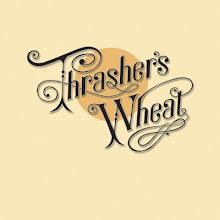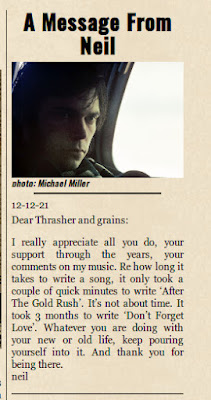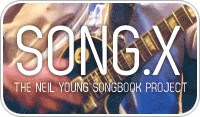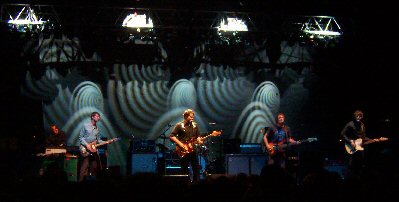Neil Young’s Rust Never Sleeps: Burning Out, Not Fading Away | Music Videos Deconstructed
Neil Young’s Rust Never Sleeps captures a moment in history where rock’s old guard was bumping up against the aftermath of punk.
Greil Marcus' wrote in his 1993 book "Ranters & Crowd Pleasers: Punk in Pop Music" on selecting "Rust Never Sleeps" as the most important album of 1979:
"Divided equally between graceful acoustic reveries and viciously hard rock, this was a sneak attack on entropy, its explicit subject. Up against the most reliable and unpredictable rock 'n' roller of the decade, entropy never had a chance --- at least while this album was playing."From Music Videos Deconstructed :
And so it is that in 1978 we get a short-haired Neil Young singing about how “it’s better to burn out than to fade away/rust”, a line which alongside Pete Townsend’s “Hope I die before I get old” captures the rock n’ roll ethos (not to mention punks ‘anarchic’ nihilism) pretty perfectly. In two versions, one acoustic, the other bludgeoningly electric, of one song ‘Hey Hey, My My’ (Out Of The Blue/In To The Black) Young filters the current zeitgeist, preceding the line above with “The King is gone but he’s not forgotten, this is the story of a Johnny Rotten” referencing the death of Elvis, the arrival of the Sex Pistols and all that seemed to represent in one killer line.
And whilst the ambient resonance of punk is most obviously referenced in ‘Hey Hey, My My’ it is every bit as evident in the trashy blast of ‘Welfare Mothers’ and the pummeling drive of ‘Sedan Delivery’, the latter’s verses delivered at positively breakneck speed by Crazy Horse standards. The entire electric part of this performance is loose limbed and slightly ragged. The music ebbs and flows, with Young acting as the conductor taking his band up and down at will. Together they make what might be labelled in England as a glorious racket.
More on Music Videos Deconstructed . (website defunct. full article below)

Burning Out, Not Fading Away: Neil Young’s Rust Never Sleeps
March 12, 2016 by Paul Brown
We take a look at a classic concert movie which captures a moment in history where rock’s old guard was bumping up against the aftermath of punk…
The late 1970’s were a strange time for the generation of rock royalty that had emerged so brightly from the previous decade. No longer the vanguard, the likes of Dylan, the Stones, The Who et al found themselves increasingly out of step especially when the twin explosions of punk and disco shook the cultural landscape to its core.
Neil Young weathered that particular storm better than most. In part this was because Young had never really been in step with his own generation anyway. Although he may have began his career in the 60’s with Buffalo Springfield it was in the 70’s that Young really flowered, releasing a string of albums that have become his core works. To this end Young surfed that high wave over and through the shifting sands beneath.
The other factor was that with Crazy Horse he had for some years been playing music which had the same un-technical, shambolic air that many an untutored punk band was currently pedalling. Crazy Horse were absolutely not musos, and in another life would have been lucky to have gotten a job with anyone else of even half Neil Young’s stature. Indeed, Young had cause to defend his backing group’s abilities to his peers on more than one occasion. When he told CSNY colleague Stephen Still that he played with them because they had soul, Stills replied “My dog’s got soul Neil, I don’t want him in my band”.
Young was right though, what Crazy Horse lacked in chops they made up for with feeling, and it’s that which Young prizes above all else and was what most delighted him about punk, which he was quick to embrace and support. In an interview at the time he said “I like that music because the people making it are alive. And they don’t give a shit. They don’t care about being number one. They don’t care about a great sounding, polished product. What they want is guts, and a good beat”.
And so it is that in 1978 we get a short-haired Neil Young singing about how “it’s better to burn out than to fade away/rust”, a line which alongside Pete Townsend’s “Hope I die before I get old” captures the rock n’ roll ethos (not to mention punks ‘anarchic’ nihilism) pretty perfectly. In two versions, one acoustic, the other bludgeoningly electric, of one song ‘Hey Hey, My My’ (Out Of The Blue/In To The Black) Young filters the current zeitgeist, preceding the line above with “The King is gone but he’s not forgotten, this is the story of a Johnny Rotten” referencing the death of Elvis, the arrival of the Sex Pistols and all that seemed to represent in one killer line.
And whilst the ambient resonance of punk is most obviously referenced in ‘Hey Hey, My My’ it is every bit as evident in the trashy blast of ‘Welfare Mothers’ and the pummeling drive of ‘Sedan Delivery’, the latter’s verses delivered at positively breackneck speed by Crazy Horse standards. The entire electric part of this performance is loose limbed and slightly ragged. The music ebbs and flows, with Young acting as the conductor taking his band up and down at will. Together they make what might be labelled in England as a glorious racket.
It’s with an acoustic performance we begin though, and slowly too. The first minutes of the performance see the ‘roadeyes’ setting the stage to the slightly disjointed strains of Hendrix’s ‘Star Spangled Banner’ and the Beatles’ ‘A Day In The Life’ for Young to emerge childlike from a box to sing ‘Sugar Mountain’ followed by ‘I Am A Child’, songs as sweet as any he has ever written. As he carries on through this section there seems to be something almost incongruous about these songs in light of what you know is to come. This is the spoonful of sugar, sweetening things for the heavy medicine Crazy Horse are about to bring.
It’s only when he launches in to the acoustic ‘Hey Hey, My My’ that the atmosphere starts to bristle a little, and only when the band launch in to searing versions of ‘When You Dance You Can Really Love’ and ‘The Loner’ that we get down to business, the latter rocking much harder than the version on his eponymous debut, and all the better for it. Indeed, fuelled by punk’s noise Young was rocking harder than he ever had. Long time Young associate Joel Bernstein would later recall of the Rust Never Sleeps tour “It was incredibly loud, unbelievably loud” and adding how in one L.A. show the entire guest section including Ahmet Ertegun and David Geffen left during the second electric song, such was the pummeling effect of the volume.
Contrarily enough the highlights come when all concerned slow the pace a little and relax in to songs that have become staples of the NY&CH ouvre. ‘Powderfinger’ and ‘Cortez The Killer’ give them a chance to stretch out a bit, with Young’s incendiary solos taking center stage, but it’s ‘Like A Hurricane’ that really soars, howls in fact, and is also the point in the concert where Young sails closest to the kind of mega-stadium ROCK that punk was trying to get away from.
And it’s his inbuilt sense of the contrary which shines through strongest on Rust Never Sleeps; acoustic troubador and hard-nosed rocker, at once both sharply in tune with the times and yet always resolutely marching to his own beat. He would lose his way a bit in the 80’s but only by steadfastly refusing to compromise his artistic drive. It’s an ethos which colours his entire career, and is how he’s managed to remain wholly contemporary without ever being even slightly fashionable. And it’s how in 1978 he was able to flourish where others floundered as a new era dawned.
Labels: neil young, rust never sleeps





































 Human Highway
Human Highway

















 Concert Review of the Moment
Concert Review of the Moment





 This Land is My Land
This Land is My Land

 FREEDOM In A New Year
FREEDOM In A New Year









 *Thanks Neil!*
*Thanks Neil!*




![[EFC Blue Ribbon - Free Speech Online]](http://www.thrasherswheat.org/gifs/free-speech.gif)











 The Unbearable Lightness of Being Neil Young
The Unbearable Lightness of Being Neil Young Pardon My Heart
Pardon My Heart



 "We're The Ones
"We're The Ones  Thanks for Supporting Thrasher's Wheat!
Thanks for Supporting Thrasher's Wheat!




 This blog
This blog 
 (... he didn't kill himself either...)
#AaronDidntKillHimself
(... he didn't kill himself either...)
#AaronDidntKillHimself









































































 Neil Young's Moon Songs
Neil Young's Moon Songs




 Civic Duty Is Not Terrorism
Civic Duty Is Not Terrorism Orwell (and Grandpa) Was Right
Orwell (and Grandpa) Was Right


 What's So Funny About
What's So Funny About 


